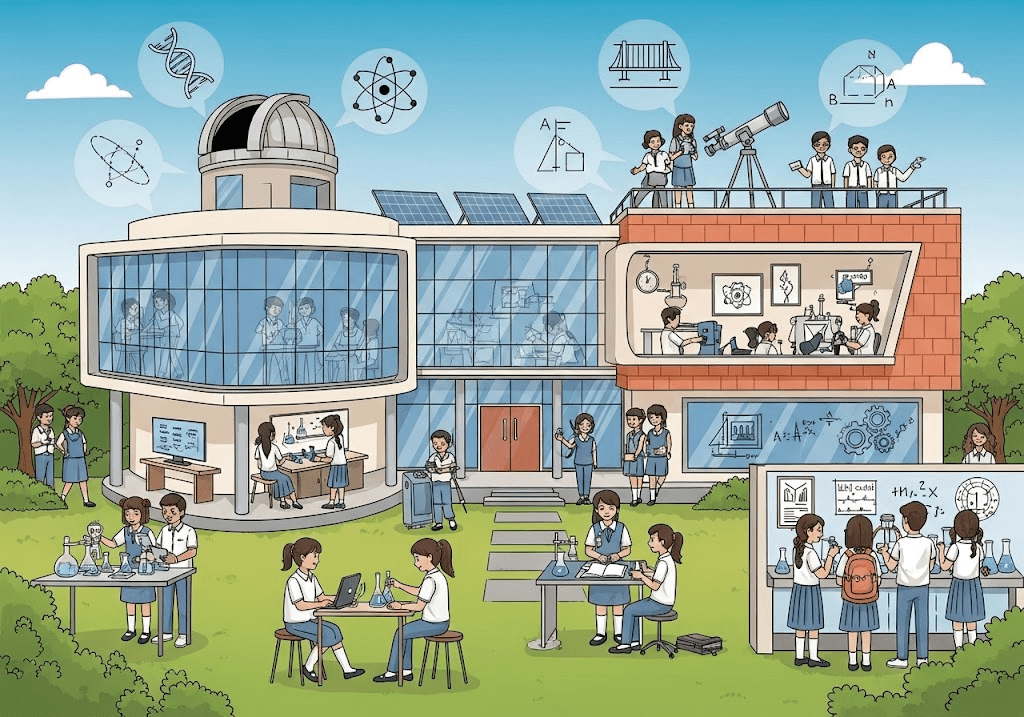How NEP 2020 is Transforming STEM Education in India for 2025: A Parent's Guide to Choosing Top Schools
The National Education Policy (NEP) 2020 has sparked a revolutionary shift in how we approach STEM education in India. As we step into 2025, parents across the country are witnessing unprecedented changes in their children's learning experiences. The SSRVM Trust, through its commitment to educational excellence and recognition programs like the Sri Sri Awards, continues to champion institutions that embrace these transformative educational practices.
Gone are the days when students memorized formulas without understanding their real-world applications. Today's educational landscape demands schools that can nurture curious minds while preparing students for careers that don't even exist yet. Let's explore how NEP 2020 is reshaping STEM education and what this means for your child's future.
The NEP 2020 Vision: Reimagining STEM Learning
The National Education Policy 2020 introduces a paradigm shift with these key features:
Holistic Development: Moving beyond subject silos to integrated learning
Critical Thinking: Emphasis on problem-solving over rote memorization
21st Century Skills: Preparing students for a technology-driven world
Multidisciplinary Approach: Breaking barriers between science, arts, and commerce
This vision directly addresses the growing demand for skilled professionals in India's expanding technology and innovation sectors.
Early STEM Integration: Building Strong Foundations
Top schools in India are now introducing STEM concepts as early as primary grades:
Play-based Learning: Using games and activities to teach scientific concepts
Inquiry-based Approach: Encouraging students to ask "why" and "how"
Hands-on Experiments: Making abstract concepts tangible through practical activities
Nature-based Learning: Using outdoor spaces as living laboratories
These approaches ensure that children develop a natural affinity for science and mathematics from an early age.
From Memorization to Experiential Learning
The transformation from traditional teaching methods is remarkable:
Traditional Method:
Students memorize periodic table without understanding atomic structure
Mathematical formulas learned by heart without practical application
NEP 2020 Approach:
Students conduct experiments to understand chemical properties
Mathematics taught through real-world problem-solving scenarios
Physics concepts demonstrated through interactive simulations
This shift ensures deeper understanding and long-term retention of knowledge.
Technology Integration: The Digital Classroom Revolution
Progressive education now seamlessly blends traditional teaching with cutting-edge technology:
AI-Powered Learning Platforms: Personalized learning experiences for each student
Virtual Reality Labs: Exploring molecular structures and astronomical phenomena
Coding from Elementary Grades: Building computational thinking skills
Digital Fabrication: 3D printing and robotics projects
Online Collaboration Tools: Connecting with global classrooms
Future-Ready Skill Development
NEP 2020 prioritizes skills that matter in tomorrow's job market:
Computational Thinking: Breaking down complex problems into manageable parts
Design Thinking: Creative problem-solving methodologies
Data Literacy: Understanding and interpreting information in the digital age
Entrepreneurial Skills: Innovation and business acumen
Communication Skills: Presenting ideas effectively across diverse audiences
Assessment Revolution: Beyond Marks and Grades
Top CBSE schools in India are adopting new evaluation methods:
Portfolio-based Assessment: Showcasing projects and creative work
Peer Assessment: Students evaluating each other's contributions
Self-Assessment: Encouraging reflection and self-awareness
Competency-based Evaluation: Measuring understanding rather than memory
Continuous Assessment: Regular feedback instead of high-stakes exams\
Industry-School Collaboration: Bridging the Gap
Forward-thinking institutions are partnering with:
Tech Companies: Internship opportunities and mentorship programs
Research Institutions: Access to advanced laboratories and expertise
Startups: Exposure to innovation and entrepreneurial thinking
International Organizations: Global perspective on STEM challenges
STEAM Education: Balancing Science with Creativity
The evolution from STEM to STEAM (adding Arts) reflects a more holistic approach:
Design Projects: Combining engineering with aesthetic principles
Scientific Communication: Using creative mediums to explain complex concepts
Innovation Labs: Spaces where art meets science
Cross-curricular Projects: Literature inspiring scientific inquiry
Choosing the Right STEM-Focused School: A Parent's Checklist
When evaluating schools for your child, consider these crucial factors:
Infrastructure and Resources:
Well-equipped laboratories and maker spaces
Access to modern technology and software
Library resources including digital databases
Outdoor learning environments
Faculty Excellence:
Teachers with industry experience
Ongoing professional development programs
Student-teacher ratios enabling personalized attention
Mentorship programs
Curriculum Innovation:
Integration of NEP 2020 guidelines
Project-based learning opportunities
International collaborations and exchange programs
Regular curriculum updates reflecting industry trends
Recognition and Achievements:
Awards and recognitions like the Sri Sri Awards
Student achievements in national and international competitions
Alumni success stories in STEM fields
Research publications and patents
Preparing for Global STEM Opportunities
The best educational institutions prepare students for:
International University Admissions: Meeting global academic standards
Research Opportunities: Publishing papers and participating in conferences
Innovation Competitions: Showcasing creativity on world stages
Cross-cultural Collaboration: Working with diverse teams
Entrepreneurial Ventures: Starting technology-based businesses
Frequently Asked Questions
Q1: How does NEP 2020 specifically benefit STEM students? NEP 2020 promotes hands-on learning, critical thinking, and multidisciplinary approaches, making STEM subjects more engaging and practical for students.
Q2: What should parents look for in a STEM-focused school? Look for well-equipped labs, experienced faculty, project-based learning, industry partnerships, and a track record of student achievements in STEM competitions.
Q3: How early should children start learning STEM concepts? STEM learning can begin as early as preschool through play-based activities, gradually progressing to more structured learning in elementary grades.
Q4: Are traditional schools adapting to NEP 2020 requirements? Yes, most established schools are upgrading their infrastructure, training teachers, and modifying curricula to align with NEP 2020 guidelines.
Q5: How important is coding in the new STEM curriculum? Coding is considered essential as it develops logical thinking, problem-solving skills, and prepares students for technology-driven careers.
Q6: What role do parents play in supporting STEM education at home? Parents can encourage curiosity, provide STEM-related books and activities, support school projects, and expose children to science museums and technology events.
Q7: How can students balance STEM with other subjects under NEP 2020? NEP 2020 promotes multidisciplinary learning, allowing students to explore connections between STEM and humanities, arts, and social sciences without compromising depth.
The future belongs to students who can think critically, solve complex problems, and adapt to rapidly changing technologies. By choosing schools that embrace NEP 2020's vision for STEM education in India, parents can ensure their children are prepared not just for today's challenges, but for opportunities we haven't yet imagined. The transformation is here the question is whether we're ready to embrace it.

